Guide H-659
Richard Heerema
College of Agricultural, Consumer and Environmental Sciences, New Mexico State University
Author: Extension Pecan Specialist, Department of Extension Plant Sciences, New Mexico State University. (Print Friendly PDF)
Introduction
Pecan orchards are long lived and an expensive investment. Choosing the right cultivars to plant in your pecan orchard is one of the most basic of decisions for your long-term success, and has been called the “foundation of the orchard” (Sparks, 1992).
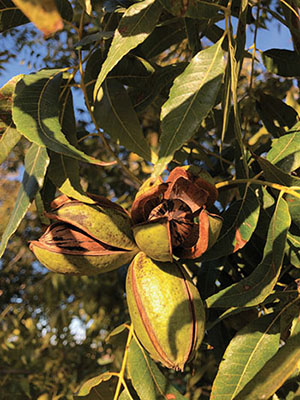
Some factors (or “traits”) to consider when selecting pecan cultivars for your orchard are:
- Tree structural strength and branching properties
- Pollination pattern
- Age of tree when first nut crops are expected (“precocity”)
- Nut yield potential to expect at maturity (“prolificacy”)
- Tendency to alternate bear
- Date of kernel ripening and shuck split
- Nut size potential
- Kernel percentage potential
- Kernel appearance, including shape and color
- Susceptibility to stresses caused by pests or diseases (biotic stresses)
- Susceptibility to stresses caused by non-living factors in the environment (abiotic stresses, e.g., micronutrient deficiencies, freeze injury, salinity injury)
Matching a Pecan Cultivar to New Mexico’s Climate and Soils
The traditional commercial pecan cultivars used in New Mexico, such as ‘Western’, ‘Ideal’, and ‘Wichita’, require a relatively long, hot growing season. They may need 200 or more frost-free days in order to fully mature a nut crop. This is why commercial pecan production in New Mexico has been primarily limited to lower-elevation areas (<4,500 feet above sea level) in the southern counties (Doña Ana, Luna, Otero, Eddy, Chaves, and Lea). There are some unique “microclimates” in other parts of the state that may present exceptions to the rule, but most parts of New Mexico outside the usual southern pecan growing areas have too short a growing season to reliably ripen a nut crop with traditional late-ripening pecan cultivars before the first freezing weather arrives ins the fall. Earlier-ripening cultivars are available that may more reliably produce pecan crops in areas of the state with a shorter and/or cooler growing season.
In addition to the length and heat of the growing season, another important climate consideration is the minimum temperature that can be expected during the dormant season. When they are fully dormant in winter, healthy pecan trees are generally quite tolerant of freezing temperatures, but there are limits to this that vary with the genetics of the cultivar. Cultivars whose genetic origins lie in the colder parts of the pecan’s native range (e.g., Kansas or Missouri) typically can withstand much lower dormant season temperatures without injury than those that originate from the warmer parts of the native range (e.g., central Texas or Mexico).
New Mexico’s soils have alkaline pH, which decreases the availability of micronutrients such as zinc. Pecans have a very high zinc requirement compared to other crops, and in New Mexico, zinc deficiency is common in pecan orchards without active zinc fertilization programs. Pecan cultivars vary widely in their susceptibility to zinc deficiency, and the ease of success in managing zinc nutrition can be increased by selecting cultivars that are less susceptible to zinc deficiency.
Pollination in Pecans
Pecan cultivars can be grouped into two pollination types based on the time in the spring that male flowers shed pollen relative to the time female flowers are receptive to pollen (see Table 1). There is one group of cultivars where the male flowers begin to shed pollen before their female flowers become receptive to pollen. These cultivars are called Type I (or “protandrous”; prot- = first -androus = male) cultivars. The other group of pecan cultivars begins to shed pollen after their female flowers become receptive, and are called Type II (or “protogynous”; prot- = first -gynous = female) cultivars. To maximize pollination success, commercial pecan orchards should be planted with pollinizer cultivars that are in the opposite pollination type of the main cultivar and are known to have flowering timing that complements the flowering of the main cultivar. Planting orchards so that 20–40% of the trees are pollinizer cultivars (with pollination/receptivity patterns complementary to the main cultivar) helps maximize fruit set and nut production. Figures 1 and 2 show examples of male and female flowers.
|
Table 1. Average Dates and Duration of Pollen Shedding and Stigma (female) Receptivity of Selected Pecan Varieties in Southern New Mexico |
||||||||||||||||||||||||||
|
Approximate Dates |
||||||||||||||||||||||||||
|
April |
May |
|||||||||||||||||||||||||
|
Variety |
28 |
29 |
30 |
1 |
2 |
3 |
4 |
5 |
6 |
7 |
8 |
9 |
10 |
11 |
12 |
13 |
14 |
15 |
16 |
17 |
18 |
19 |
20 |
21 |
22 |
23 |
|
Protandrous Varieties |
||||||||||||||||||||||||||
|
Barton |
||||||||||||||||||||||||||
|
Cherokee* |
||||||||||||||||||||||||||
|
Cheyenne* |
||||||||||||||||||||||||||
|
Harper |
||||||||||||||||||||||||||
|
Mesilla |
||||||||||||||||||||||||||
|
San Saba |
||||||||||||||||||||||||||
|
Western |
||||||||||||||||||||||||||
|
Protogynous Varieties |
||||||||||||||||||||||||||
|
28 |
29 |
30 |
1 |
2 |
3 |
4 |
5 |
6 |
7 |
8 |
9 |
10 |
11 |
12 |
13 |
14 |
15 |
16 |
17 |
18 |
19 |
20 |
21 |
22 |
23 |
|
|
Apache* |
||||||||||||||||||||||||||
|
Burkett |
||||||||||||||||||||||||||
|
Chickasaw* |
||||||||||||||||||||||||||
|
Choctaw* |
||||||||||||||||||||||||||
|
Comanche* |
||||||||||||||||||||||||||
|
Ideal |
||||||||||||||||||||||||||
|
Mohawk* |
||||||||||||||||||||||||||
|
Rincon |
||||||||||||||||||||||||||
|
Shawnee* |
||||||||||||||||||||||||||
|
Sioux* |
||||||||||||||||||||||||||
|
Tejas* |
||||||||||||||||||||||||||
|
Wichita |
||||||||||||||||||||||||||
|
*Blossom data collected at Brownwood, TX, and adjusted to southern New Mexico’s growing season. |
||||||||||||||||||||||||||
|
Pollen Shedding |
Stigma Receptivity |
|||||||||||||||||||||||||
For many pecan cultivars, pollen shed and female flower receptivity in the spring are completely separated in time, making self-pollination impossible. Some other cultivars normally have partial overlap in the timing of pollen shed and female receptivity, allowing self-pollination and fruit set even in the absence of pollinizer cultivars. Some New Mexico producers have planted single-cultivar blocks using cultivars with overlapping pollen shed and female receptivity and have been generally successful in doing this. Nevertheless, this is not a recommended practice for two important reasons:
1) Pecan nuts resulting from self-pollination events are smaller and more poorly filled on average than those resulting from cross-pollination events.
2) Timing of male and female flowers may be affected differently by year-to-year variation in springtime weather, so that the amount of overlap of pollen shed and female flower receptivity in that single cultivar can be quite low in some years.
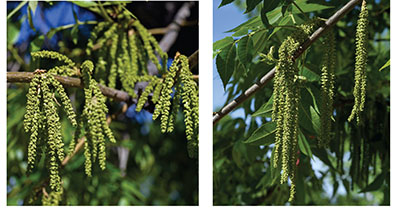
Figure 1. ‘Western’ (left) and ‘Wichita’ (right) catkins (male inflorescences) near Las Cruces, NM, on April 27, 2017.
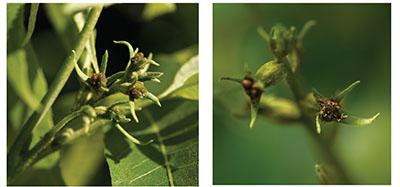
Figure 2. ‘Western’ (left) and ‘Wichita’ (right) female flowers near Las Cruces, NM, on April 27, 2017.
Temporary Trees
From an economic standpoint, the most difficult aspect of successful pecan production is the long wait from the time of planting the trees to the time when the first nut crop is harvested and revenues begin to flow in. To increase revenues from the land during the orchard’s early years, some pecan producers start their orchards at higher-than-usual planting densities, with the goal of removing temporary trees when the orchard begins to crowd (perhaps after 10–15 years, depending on orchard design and tree vigor). Using very precocious cultivars as temporary trees might allow these temporary trees to “pay for themselves” faster, making the higher-density approach more likely to be worthwhile economically.
A problem common to very precocious cultivars when they become mature trees is that they tend to overbear, which results in poor nut quality, and are prone to severe alternate bearing. If very precocious cultivars are planted as temporary trees, they should be removed from the orchard before overbearing becomes a problem. In New Mexico, it is most common to transplant temporary trees to a new orchard (rather than discarding the temporary trees), but if that is the goal, very precocious cultivars should be avoided in favor of standard cultivars.
Selected Cultivar Descriptions
Note: It is convention to list the parentage with the female first and the male/pollen parent second. For example, in the case of ‘Harper’, the female parent is ‘Mahan’ and the pollen parent is ‘Western’. This information is usually not available for native or seedling selections.
‘Burkett’
Parentage: Native selection from Callahan County, TX, introduced in 1911.
Pollination pattern: Protogynous
This cultivar is popular today in New Mexico as a landscape tree and in home orchards because of its reputation for producing nuts with excellent flavor. It is sometimes used in the commercial pecan industry as a source for rootstock seed, but more rarely for shelling nut production. These trees grow vigorously, producing a naturally symmetrical and spreading top. They are not precocious, and nut yields are mediocre at maturity by commercial standards. ‘Burkett’ is a late-ripening cultivar and is thus best adapted to areas of New Mexico with long growing seasons and high temperatures. When well developed, ‘Burkett’ nuts are uniformly large (45–60 nuts/lb) and very round (Figure 3). The shells are moderately thin and the kernels are easily extracted in halves when hand-shelled. The kernels have dark freckles, which can be considered an undesirable trait for commercial nut production. Average kernel yield is 50–58%. Black pecan aphids seem to have a strong affinity for this cultivar.
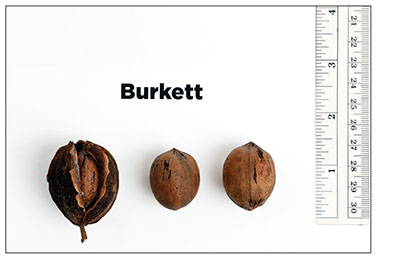
Figure 3. ‘Burkett’ nuts.
‘Cheyenne’
Parentage: Controlled cross of ‘Clark’ × ‘Odom’ from the USDA Pecan Breeding Program, released in 1970.
Pollination pattern: Protandrous
‘Cheyenne’ nuts are generally medium-sized at 55–60 nuts/lb, sometimes lower. The kernel color is light and golden with high oil content and excellent flavor. The kernel surfaces have a distinctive wrinkled appearance. The nuts yield 57–61% kernels. ‘Cheyenne’ trees are medium-sized trees with profuse lateral branching. They are highly productive and precocious. This variety has some fruit set problems and has a tendency for severe alternate bearing. This cultivar is highly susceptible to yellow and black-margined aphid infestation. ‘Cheyenne’ was once a popular cultivar for the West but has fallen out of favor for use in commercial orchards.
‘Creek’
Parentage: Cross between ‘Mohawk’ and probably ‘Western’ from the USDA Pecan Breeding Program, released in 1996.
Pollination pattern: Protandrous
‘Creek’ is most noted for being a very precocious and prolific producer of large pecans (54 nuts/lb). The shells are thick, which contributes to the relatively low average percentage kernel of 49%. The precocity of ‘Creek’ could make it a good choice for use as temporary trees in high-density plantings.
‘Harper’
Parentage: A controlled cross of ‘Mahan’ × ‘Western’ from the NMSU Agricultural Experiment Station breeding program, released in 1967. Named for Dr. Roy Harper, who made the original cross.
Pollination pattern: Protogynous
Budbreak is slightly later in spring than ‘Western’, giving ‘Harper’ a little lower risk for injury by late spring frosts. Has less severe alternate bearing than ‘Western’ or ‘Wichita’. Nuts mature about ten days earlier than ‘Western’ and are about 20% larger (53–60 nuts/lb). They are longer than ‘Western’ nuts and are more tapered from apex to base. Shucks separate from nuts readily, leaving few sticktights. Shells are thin. Kernels are straw colored and relatively smooth. Kernel quality is more uniform than either ‘Western’ or ‘Wichita’. Shell-out yields 55–60% kernels on average, but may have lower fill in some years. Not usually offered by commercial nurseries in the western U.S. today.
‘Ideal’ (synonym ‘Bradley’)
Parentage: Native selection from San Saba County, TX, introduced in the early 1930s.
Pollination pattern: Protogynous
‘Ideal’ trees grow rapidly, but compared with ‘Western’ or ‘Wichita’, ‘Ideal’ may be slower to come into bearing and less productive at maturity. ‘Ideal’ trees can have a large first fruit drop, possibly a self-thinning mechanism. They tend to have a relative low tendency toward alternate bearing. Nuts of this cultivar have exceptionally good quality, with high oil content and superb flavor, but are relatively small (70–80 nuts/lb; Figure 4). They are nearly always well filled (typically 55–60% kernel), even when the trees have a heavier crop. Kernels separate easily from thin shells. Nuts mature 10–14 days earlier than ‘Western’. Especially when the trees are immature, they are susceptible to injury from severe fall and winter freezes. Frequently used in New Mexico as a pollinizer for ‘Western’, but may shed pollen too late for ‘Western’ in some years. Readily available from commercial nurseries.
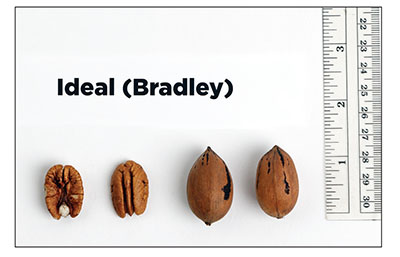
Figure 4. ‘Ideal’ kernels and nuts.
‘Kanza’
Parentage: Controlled cross of ‘Major’ × ‘Shoshoni’ from the USDA Pecan Breeding Program made in 1955. Released in 1996.
Pollination pattern: Protogynous
Appears to be a good pollinizer cultivar for ‘Pawnee’. Produces high-quality pecans in areas with cold winters and short growing seasons. The nuts, however, are small (74–77 nuts/lb; Figure 5) and have a thick shell. Average percent kernel is 51–54%. As is often the case with cultivars having small nuts, ‘Kanza’ nuts tend to fill well even in seasons when the trees are subjected to moderate environmental stresses or overcropping. Ripens early, about the same time as ‘Pawnee’. Has not been widely planted in the southwestern U.S. Readily available from commercial nurseries.
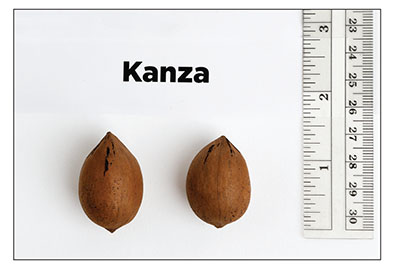
Figure 5. ‘Kanza’ nuts.
‘Lakota’
Parentage: Controlled cross of ‘Mahan’ × ‘Major’ made in 1964. Released cooperatively by the USDA Pecan Breeding Program and Kansas State University in 2007.
Pollination pattern: Protogynous
May be used as a pollinizer for ‘Pawnee’. Nuts are medium-sized at 59–66 nuts/lb (Figure 6). Very high-quality nuts with kernel shell-out of 57–62%. Beautiful light kernel color. Early ripening cultivar, about two weeks after ‘Pawnee’. Appears at this time to be a good choice especially for cooler, shorter-season growing areas in New Mexico. Susceptible to overbearing, which will lead to severe alternate bearing. When nut crop loads are excessive, cold hardiness of the trees can be severely compromised in the following winter. Readily available from commercial nurseries.
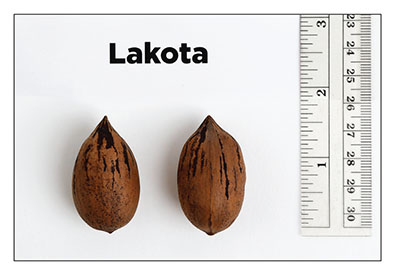
Figure 6. ‘Lakota’ nuts.
‘Lipan’
Parentage: Controlled cross of ‘Cheyenne’ × ‘Pawnee’ made in 1986. Released in 2011, ‘Lipan’ is the newest USDA-ARS cultivar.
Pollination pattern: Protandrous
‘Lipan’ nuts are quite large (Figure 7), with 44–46 nuts/lb for younger trees, but it remains to be seen whether nut size will decline as trees age. Percentage kernel is 53–55%. Another early ripening cultivar, ‘Lipan’ ripens about two weeks after ‘Pawnee’. This is a promising cultivar, but little is known at this time about how ‘Lipan’ will perform under southwestern U.S. growing conditions. Available from some nurseries.
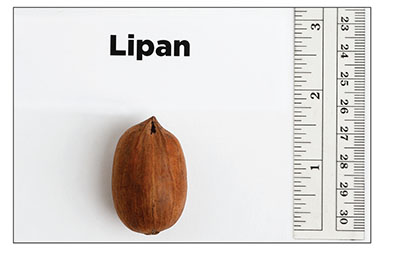
Figure 7. ‘Lipan’ nut.
‘Mesilla’
Parentage: Controlled cross of ‘Onliwon’ × ‘Humble’ from the NMSU Agricultural Experiment Station breeding program.
Pollination pattern: Protandrous
This cultivar produces vigorous, stately trees. ‘Mesilla’ is primarily useful in the landscape, producing both an abundance of nuts and shade. The trees are precocious and prolific. The abundant foliage is resistant to black pecan aphid. Shucks separate readily from the nuts. ‘Mesilla’ may produce 10% blank nuts (unfilled nuts or “pops”) in some seasons. The nuts are large (47–55 nuts/lb) with medium to thick shells. Kernels shell out well and have excellent flavor. Percent kernel is highly variable among seasons, ranging from 50–61%. Not offered by commercial nurseries in the western U.S. today. The author is unaware of any existing ‘Mesilla’ trees, and this cultivar may now be extinct.
‘Nacono’
Parentage: Controlled cross of ‘Cheyenne’ × ‘Sioux’ made in 1974. Released in 2000.
Pollination pattern: Protogynous
‘Nacono’ produces a very large, extremely high-quality nut (Figure 8), with 43–44 nuts/lb, 56–57% kernel, and light kernel color. Yield potential for ‘Nacono’ appears to be higher than for ‘Pawnee’. Nuts on young trees are susceptible to suture split, a negative quality trait. It remains to be seen whether this problem continues as the tree ages. Ripens relatively late (possibly about the same time as ‘Wichita’), so ‘Nacono’ is probably best suited for areas of New Mexico with a long growing season. As with its parent ‘Cheyenne’, ‘Nacono’ has high susceptibility to yellow and black-margined pecan aphids. ‘Nacono’ is available from some commercial nurseries.
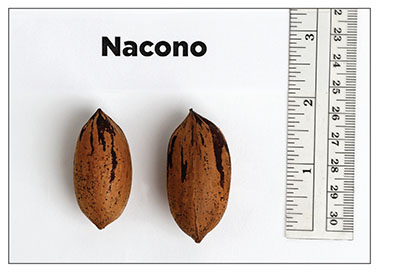
Figure 8. ‘Nacono’ nuts.
‘Navaho’
Parentage: Controlled cross of an unnamed selection and ‘Wichita’ made by the USDA Pecan Breeding Program in 1974. The female parent is a controlled cross of ‘Moore’ × ‘Schley’ from 1948. Released in 1994.
Pollination pattern: Protandrous
‘Navaho’ is noted for being a very precocious and prolific producer of good-quality nuts, with 62 nuts/lb and 61% kernel. This makes ‘Navaho’ a possible choice for use as temporary trees in high-density plantings.
‘Pawnee’
Parentage: Controlled cross of ‘Mohawk’ × ‘Starking Hardy Giant’ from the USDA Pecan Breeding Program, released in 1984.
Pollination pattern: Protandrous
Produces a large nut, averaging 51–58 nuts/lb (even larger nuts on young trees, around 44–49 nuts/lb; Figure 9), with 57–59% kernel. The kernels are very visually attractive and flavorful. The trees are noticeably less prolific than ‘Wichita’ or ‘Western’, but ‘Pawnee’ has the advantage of ripening the crop several weeks earlier than these traditional New Mexico cultivars. This allows producers in the cooler, shorter growing season areas of the state to avoid losses to early freezes in the fall, and allows producers in warmer areas to take advantage of potentially higher early season nut prices. ‘Pawnee’ sometimes exhibits physiological disorders, such as a high percentage of “pops” and kernel necrosis (Figure 10). ‘Pawnee’ is similar to ‘Wichita’ in that it has greater susceptibility to zinc deficiency than ‘Western’. ‘Pawnee’ continues to gain popularity as a commercial cultivar in the southwestern U.S. Readily available from commercial nurseries.
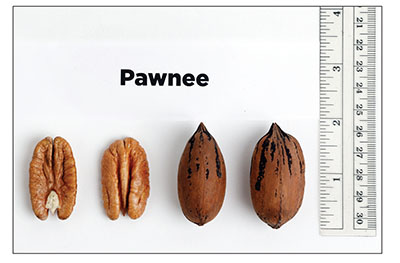
Figure 9. ‘Pawnee’ kernels and nuts.
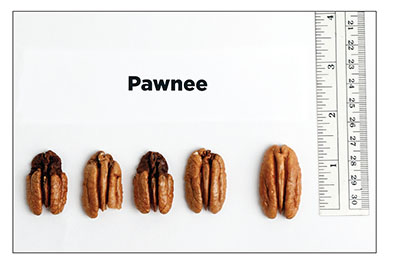
Figure 10. Kernel necrosis symptoms of varying severity are evident in the four ‘Pawnee’ kernels shown on the left.
‘Rincon’
Parentage: Believed to be a ‘Delmas’ × ‘Onliwon’ cross. Released by Archer Nursery, Rincon, NM, in 1957.
Pollination pattern: Protogynous
Trees are hardy and vigorous, and produce attractive foliage. Slow to come into bearing, but a consistent bearer at maturity. ‘Rincon’ nuts are large (45–50 nuts/lb) with a medium to thick shell. The high-quality kernels shell out cleanly. Average kernel percentage is 52–56%. Not usually offered by commercial nurseries in the western U.S. today.
‘Salopek’
Parentage: Controlled cross of ‘Wichita’ × ‘Onliwon’ from the NMSU Agricultural Experiment Station. Released by Dr. Esteban Herrera in 1990.
Pollination pattern: Protogynous
Not as prone to zinc deficiency as ‘Wichita’. Ripening and shuck split about the same time as ‘Wichita’. Nuts are large (55 nuts/lb), with thin shells that allow for easy mechanical cracking and shelling. Flavor is excellent. Not readily available from commercial nurseries.
‘San Saba Improved’
Parentage: Seedling from ‘San Saba’, a native tree growing in San Saba County, TX, introduced in 1912.
Pollination pattern: Protandrous
These trees are medium-sized and open-branched. Young trees grow reasonably well but are slow to bear. Yields at maturity are low, and as the tree ages there can be a tendency for alternate bearing. Leaves turn yellow and drop early in the fall, which can aid in harvesting, but may also be a contributing factor to the cultivar’s poor yield performance. ‘San Saba Improved’ matures two to three weeks earlier than ‘Western’, and nuts separate readily from the shucks. On young trees, the nuts are a large, in-shell type, but when the tree ages it produces a smaller nut. The slightly elongated nuts are small (72–77 nuts/lb). High kernel quality and shell-out (55–60%) make this cultivar popular with shellers. Kernel flavor is excellent. Not usually offered by commercial nurseries in the western U.S. today.
‘Sullivan’
Parentage: Reported to be a ‘Stuart’ × ‘Nugget’ cross. Released by the NMSU Agricultural Experiment Station in 1983.
Pollination pattern: Protogynous
Named in honor of the pecan production research of Dr. Darrell T. Sullivan, horticulture professor at NMSU from the 1950s to 90s. Nuts are elongated with points on both the basal and terminal ends. Nut size is intermediate between ‘Western’ and ‘Wichita’, with 65 nuts/lb on average. Shells are thin, with kernel percentage averaging 56%. ‘Sullivan’ ripens earlier than other New Mexico cultivars, about 175 days from pollination to shuck split, making it a potentially useful cultivar for areas in the state with a shorter growing season. Not readily available from commercial nurseries.
‘Waco’
Parentage: Controlled cross of ‘Cheyenne’ × ‘Sioux’ made by the USDA Pecan Breeding Program in 1975. Released in 2005.
Pollination pattern: Protandrous
Derived from the same cross as ‘Nacono’, which is evident in the very large leaves common to both cultivars. The canopies of ‘Waco’ trees are dense and strikingly beautiful, making this an excellent choice for use as landscape and shade trees. The nuts are rounder and typically smaller than ‘Nacono’, but still a large nut at an average of 53 nuts/lb (Figure 11). They have a thicker shell than ‘Western’ or ‘Wichita’. Average percentage kernel is 56%. The kernels are high-quality and usually have an attractive light color. Nut production for this promising cultivar seems to be high and consistent when grown under commercial orchard conditions in the Southwest, but only relatively young orchards (<20 years) have been observed at this point, and it remains to be seen how this cultivar continues to perform as it ages.
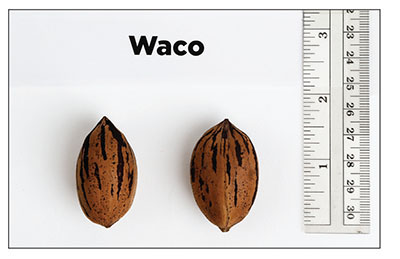
Figure 11. ‘Waco’ nuts.
‘Western’ (synonym ‘Western Schley’)
Parentage: Seedling from San Saba County, TX, introduced in 1924.
Pollination pattern: Protandrous
‘Western’ is unrelated to the cultivar named ‘Schley’, which is not used as a commercial cultivar in New Mexico. More acres in New Mexico and neighboring west Texas are planted to ‘Western’ than any other cultivar. It has long been and will continue to be the backbone of the New Mexico pecan industry. ‘Western’ trees are vigorous and precocious. Production typically begins in the sixth or seventh year. ‘Western’ is sometimes called the “workhorse” cultivar of the West because trees are reliable, heavy producers at maturity. It branches profusely along major scaffold limbs, and therefore responds extremely well to mechanical hedge pruning. ‘Western’ is much less susceptible to zinc deficiency than many other cultivars. It also seems to be less affected by water stress and heat than other cultivars. ‘Western’ is usually a consistent producer, but can overbear in some years. Nuts are relatively late-maturing (late October/early November) and, as a result, early fall freezes in some years can cause nuts to remain in the shuck even in the warmest growing areas. In ‘Western’, the period of pollen shed can overlap with its period of female flower receptivity so that significant self-pollination may occur. It is best, however, to plant ‘Western’ with a protogynous pollinizer cultivar such as ‘Wichita’ or ‘Ideal’ (‘Bradley’). ‘Western’ nuts are elongated, rounded on the stem end and tapered toward the terminal apex (Figure 12). Shells are thin. Nuts are normally medium-sized (often 63–74 nuts/lb) with 55–60% kernel, but nuts from overbearing ‘Western’ trees are smaller with low percentage kernel. Readily available from commercial nurseries.

Figure 12. ‘Western’ kernels and nuts.
‘Wichita’
Parentage: Controlled cross of ‘Halbert’ × ‘Mahan’ made by the USDA Pecan Breeding Program in 1940. Released in 1959.
Pollination pattern: Protogynous
In New Mexico, ‘Wichita’ is the one of the most common pollinizers planted in orchards having ‘Western’ as the main cultivar. ‘Wichita’ is a common main cultivar in Arizona, California, and the Mexican state of Sonora. Compared with ‘Western’, ‘Wichita’ is more precocious, typically bearing its first crop five or six years after planting. It is very prolific at maturity, with a tendency to overbear. ‘Wichita’ nuts are larger than ‘Western’; there may be 50–62 nuts/lb, although they sometimes average 44 nuts/lb (Figure 13). The nuts may be smaller in years of excessive production. They yield 56–62% kernels. ‘Wichita’ is readily available from commercial nurseries.

Figure 13. ‘Wichita’ kernels and nuts.
Despite many advantages for ‘Wichita’ as a cultivar, it also presents numerous challenges for production. ‘Wichita’ branches tend to be weak and may break where high winds occur frequently; however, careful branch selection during the tree training phase can reduce this defect. Trees are highly susceptible to zinc deficiency, requiring an intensive zinc management program for proper growth. A number of physiological disorders in ‘Wichita’ can negatively affect nut yield and quality to a greater extent than in ‘Western’:
- Water stage fruit split can occur when there is high humidity or precipitation during the water stage in August, causing the nuts to abort.
- After the first fall freeze occurs before harvest, there can be a high percentage of “sticktights” (adherent shucks).
- Kernels turn amber quickly when hot temperatures occur during harvest, a factor that could negatively affect its final price.
- Pre-germination of nuts can occur when very warm weather persists through the latest stages of nut development.
Frequently asked questions
What Is a Cultivar?
The term cultivar comes from a joining of the words cultivated and variety. It refers to a genetically related group of horticultural or agricultural plants that retains a set of traits predictably when these plants are propagated. Informally, in the pecan industry the terms “cultivar” and “variety” are often used interchangeably. Pecan cultivars are normally propagated clonally by grafting or patch budding to a seedling rootstock.
Do I Need to Plant a Scab-resistant Cultivar in New Mexico?
The short answer is “no.” Pecan scab is one of the most damaging diseases affecting pecan trees, causing major reductions in nut yield and quality in infected orchards. In pecan production areas in the southeastern and south-central U.S., high rainfall and humidity create conditions ideal for fungal diseases, especially pecan scab. Fungicide sprays are a very expensive input for producers, so genetic resistance to this disease is an extremely important consideration for pecan cultivar selection in those areas. Fortunately, however, here in New Mexico our semiarid climate is not conducive to pecan scab, and susceptible pecan cultivars may be grown with no problem.
What Are the Differences Between “Native,” “Seedling,” and “Controlled Cross” Cultivar Selections?
Native selections are cultivars selected and clonally propagated directly from trees growing in “wild” groves within the native range for pecans. Most often, such cultivars were selected specifically for easily observed fruit quality traits, such as nut size. The pedigrees of native selections are typically unknown.
Seedling selections are cultivars selected and clonally propagated from ungrafted trees, but not from native trees. (Note: The descriptor “seedling” in this case does not necessarily mean that the tree is young, but rather that it was grown from a seed and was not grafted.) Sometimes the female parent of a seedling selection is known and may even be another named cultivar. However, the pollen parent of a seedling selection is usually known with certainty only if it has been tested using modern genetic techniques.
Controlled crosses are cultivars where both the female and pollen parents are known, and were in fact intentionally selected. Pecan breeders choose a pair of cultivars to cross where a specific combination of particular traits may be desired—for example, one parent may contribute the trait of early nut ripening, while the other parent might contribute the trait of disease resistance. Breeders artificially apply pollen from the intended pollen parent to the flowers’ receptive stigmas on the intended female parent, and they bag the female flowers to prevent pollination from other trees. Just because a pecan tree comes about as the result of a controlled cross from parent trees with desirable genetic qualities does not guarantee that it will be a good commercial cultivar. Pecan trees grown from such crosses must undergo very long periods of intensive field testing to determine if they do indeed express the desired combination of traits and to determine their suitability for release as commercial cultivars. The USDA-ARS Pecan Breeding Program has released the largest number of controlled cross cultivars, mostly bearing Native American tribal names. Other breeding programs, including one at NMSU, have also released controlled cross pecan cultivars.
It takes much too long to develop new improved pecan cultivars. What can pecan breeders do to speed up this process?
It does take much too long to develop new pecan cultivars! The genetics of annual crops can be improved quickly because the generation time is short—sometimes multiple generations can be evaluated in a single season. Long-lived perennial crops, like pecans, take a long time to improve genetically because it takes decades to evaluate cultivars and make subsequent crosses. Even our newest pecan cultivars are only a very few generations away from their wild ancestors.
NMSU is currently leading a major effort to increase our understanding of pecan genetics, and thereby dramatically speed up the process of developing new and better cultivars for U.S. pecan producers. This work is funded through a large grant from the USDA Specialty Crops Research Initiative entitled “Coordinated Development of Genetic Tools for Pecan*.” The larger team of scientists also includes researchers from HudsonAlpha, Noble Research Institute LLC, University of Arizona, University of Georgia, Texas A&M University, and USDA-ARS.
As part of the project, four pecan genomes representing regional diversity have been sequenced to the chromosome level, and the functions of many of the genes have been identified. The data from this research will allow breeders to use genetic marker-based approaches to pecan cultivar improvement, which will hopefully make the whole process of selecting for particular traits easier and faster in the near future.
*USDA-NIFA-SCRI 2016-51181-25408
Sources and Further Reading
Garcia, G., and A.B. Fite. 1925. Preliminary pecan experiments [Bulletin No. 145]. Las Cruces: New Mexico College of Agriculture and Mechanic Arts, Agricultural Experiment Station.
Goff, B. 2015. Pecan cultivar recommendations for the Southeast. Alabama Pecan Growers Association. http://www.alabamapecangrowers.com/cultivars.html
Grauke, L.J. n.d. USDA-ARS Pecan Breeding Program: National collection of genetic resources for pecans and hickories. https://cgru.usda.gov
Herrera, E.A. 1994. ‘Salopek’ pecan. HortScience, 29, 220.
Nakayama, R.M. 1967. Pecan variety characteristics [Bulletin 520]. Las Cruces: New Mexico State University Agricultural Experiment Station.
Smith, M.W. 2012. Kernel necrosis of ‘Pawnee’ pecan: Expanded distribution and relation to yield, tree size, and canopy location. HortScience, 47, 465–467.
Smith, M.W. 2012. Fruit production characteristics of ‘Pawnee’ pecan. HortScience, 47, 489–496.
Sparks, D. 1992. Pecan cultivars: The orchard’s foundation. Watkinsville, GA: Pecan Production Innovations.
Thompson, T.E. 1985. ‘Pawnee’ pecan. HortScience, 20, 776.
Thompson, T.E., and L.J. Grauke. 2001. ‘Nacono’ pecan. HortScience, 36, 1162–1163.
Thompson, T.E., and L.J. Grauke. 2012. ‘Lipan’ pecan. HortScience, 47, 121–123.
Thompson, T.E., and F. Young. 1985. Pecan cultivars–Past and present. College Station: Texas Pecan Growers Association, Inc.
Thompson, T.E., L.J. Grauke, and L. Lombardini. 2005. ‘Waco’ pecan. HortScience, 40, 2207–2208.
Thompson, T.E., L.J. Grauke, and W. Reid. 2008. ‘Lakota’ pecan. HortScience, 43, 250–251.
Thompson, T.E., L.J. Grauke, and J.B. Storey. 1995. ‘Navaho’ pecan. HortScience, 30, 156–157.
Thompson, T.E., L.J. Grauke, W. Reid, M.W. Smith, and S.R. Winter. 1997. ‘Kanza’ pecan. HortScience, 32, 139–140.
Wells, L., and P. Conner. 2012. Pecan varieties for Georgia orchards [Circular 898]. Athens: University of Georgia Cooperative Extension. https://secure.caes.uga.edu/extension/publications/files/pdf/C%20898_4.PDF
Wilson, C.P. 1911. Pecan culture as adapted to Mesilla Valley conditions [M.S. Thesis]. Las Cruces: New Mexico College of Agriculture and Mechanic Arts.
Acknowledgments
All photographs taken by Andrés Leighton.
Some information in this guide is based on a publication originally authored by Esteban Herrera, former NMSU Extension Horticulturist.
For further reading
H-605: Training Young Pecan Trees
https://pubs.nmsu.edu/_h/H605/
H-640: Irrigation Scheduling of Pecan Orchards: Soil Moisture Monitoring
https://pubs.nmsu.edu/_h/H640/
H-657: Diseases and Other Disorders of Pecan in New Mexico
https://pubs.nmsu.edu/_h/H657/

Richard Heerema is the Extension pecan specialist. He earned his Ph.D. in plant biology from the University of California—Davis. His research includes micronutrient nutrition, irrigation efficiency, rootstocks, and alternate bearing in pecan. His Extension work provides New Mexico's growing pecan industry with research-based information and tools needed to maximize profitability and sustainability.
To find more resources for your business, home, or family, visit the College of Agricultural, Consumer and Environmental Sciences on the World Wide Web at pubs.nmsu.edu.
Contents of publications may be freely reproduced, with an appropriate citation, for educational purposes. All other rights reserved. For permission to use publications for other purposes, contact pubs@nmsu.edu or the authors listed on the publication.
New Mexico State University is an equal opportunity/affirmative action employer and educator. NMSU and the U.S. Department of Agriculture cooperating.
June 2021 Las Cruces, NM


